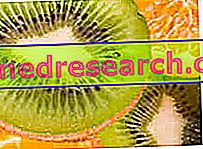Fibers: what are they?
Dietary fibers are a heterogeneous group of molecules (for example, some complex glucides or lignin) composed of glycosidic bonds that cannot be hydrolysed (broken) by the human digestive enzymes of saliva, pancreatic juices and intestinal brush rim.

NB . The wording viscous and non-viscous fibers is NOT synonymous with soluble and insoluble. From some researches it has been observed that the solubility of the fibers does not always represent a valid prediction criterion of the ability to gel, therefore of their potential metabolic effect; nevertheless, the terms soluble fiber and insoluble fiber are still widespread among nutrition and human nutrition professionals.
Viscous and non-viscous fibers: which are the most common in human nutrition?
The fibers most commonly found in consumer foods are:
- Lignin: complex and three-dimensional polyphenolic compound contained in the cell wall of plants
- Cellulose: complex polymeric glucide with β-1, 4 glycosidic bonds contained in the cell wall of plants
- Beta-glucans: complex polymeric glucides with β-1, 3 and β-1, 4 glycosidic bonds (mainly contained in oats and barley)
- Hemicellulose: mixed complex polymeric glucides (formed by pentose and hexose) which, like cellulose, are contained above all in the cell wall of plants
- Pectins: viscous complex polymeric glucides contained mainly in fruit
- Tires: viscous complex polymeric glucides contained mainly in seeds
- Inulin and oligofructose: polymeric glucides (long and short) viscous complexes composed of fructose ending with a glucose molecule; they are found mainly in roots and bulbs such as onions and Jerusalem artichokes
- Resistant or NOT available starch: typical of plant cell walls, it cannot be digested because it is seized by other components that are not digestible or because it is structurally altered; RAW's bananas and legumes are abundant sources. NB : Resistant or NON-digestible starch can be formed / converted by cooking or cooling.
SOLUBLE FIBERS | NON-SOLUBLE FIBERS |
Beta-glucans, gums, mucilages (eg, psyllium, flax), pectins and some hemicelluloses Oats and derivatives, carrots, onion, apple peel and citrus fruit albedo, and legumes (dried beans, peas and lentils) are excellent sources of soluble fiber | Cellulose, lignin, some pectins and some hemicelluloses |
FIBER VISCOSE | NON VISCOSE FIBERS |
Pectins, beta-glucans, some gums (guar gum) and mucilages (psyllium) | Cellulose, lignin, and some hemicelluloses |
FERMENTABLE FIBERS | NON-FERMENTABLE FIBERS |
Pectins, beta-glucans, guar gum, inulin, and FOS are rapidly fermented. Foods that are rich in fermentable fiber are oats and barley, as well as fruits and vegetables | Cellulose and lignin. Grain fibers very rich in cellulose, such as wheat bran, are relatively resistant to bacterial fermentation |
Viscous and non-viscous fibers: what are they for?
Viscous fibers and non-viscous fibers have several common characteristics; for example, both types of dietary fiber:
- They prevent and treat intestinal constipation
- They intervene positively on the prevention of diverticular disease
- They intervene positively on the prevention of the accumulation of toxic and carcinogenic waste (even if the correlation between dietary fiber and colorectal cancer is not yet well defined)
On the other hand, the different fibers have different chemical-physical properties. The viscous ones are characterized by a remarkable solubility; they, diluted in water, form a real gel, while the non-viscous ones remain intact and (after bacterial fermentation in the colon) favor the production of intestinal gases.
The most interesting aspect concerning the intake of viscous and non-viscous fibers was highlighted by a randomized study by the NIH-AARP - Diet and Health Study, conducted on subjects in the geriatric age; this research has shown that: the sample of elderly characterized by a diet with higher fiber intake (both viscous and non-viscous) has a mortality rate of 22% LOWER than that with a diet poor in fibrous components.
Viscous and non-viscous fibers (in quantities of around 30g / day) preserve the health of human beings and prevent the onset of certain diseases, especially in old age.
Viscous fibers: how are they different from NON-viscous ones?
The viscous fibers (which are mostly contained in oats, legumes, fruit and vegetables) include the group of pectins, beta-glucans, some gums (for example, guar gum) and mucilages (for example, psyllium ); these are typically soluble molecules that mainly determine:
- An increase in satiety by mechanical action on the walls of the stomach
- A modulation of intestinal absorption, more precisely:
- They intervene positively on the prevention of type 2 diabetes mellitus (more total fiber in the diet leads to an improvement in the glycemic index and a decrease in the glycemic load)
- They positively intervene on the prevention of some cardiovascular diseases (more total fibers in the diet determine an optimal modulation of the absorption of lipids with improvement of the blood's fat profile).
More precisely, the viscous fibers play a decisive role in the modulation of the lipidemia, REDUCING the LDL cholesterol in serum (commonly called "bad"); moreover, by modulating the absorption of energy nutrients by moderating the glycemic index of the meal, with a beneficial effect on the overall insulin response.



